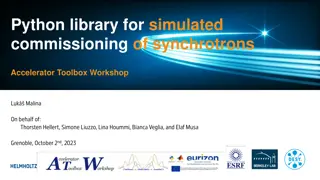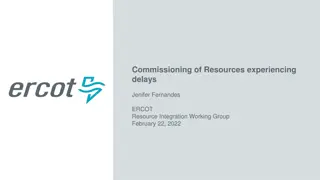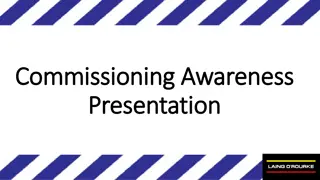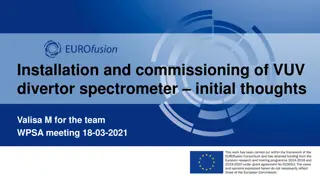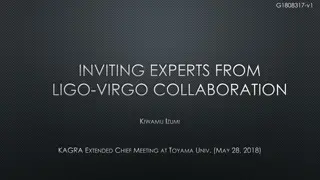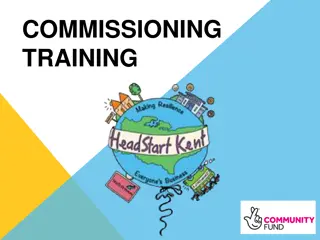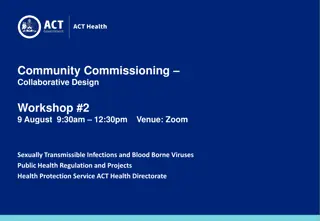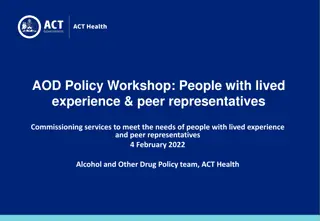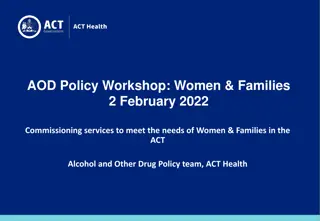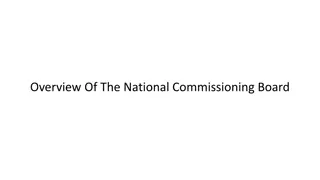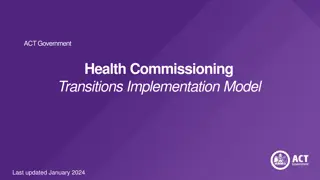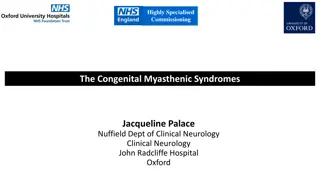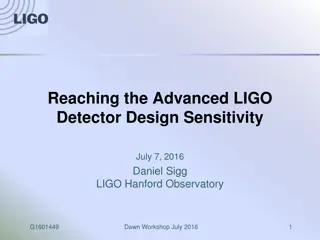Pre-Commissioning and Commissioning Activities Overview
Understanding the process of pre-commissioning and commissioning in a treatment unit to ensure all systems are operational and ready for use. Learn about the activities involved, from preparation to treatment processes, including primary and secondary treatments. Explore the key steps such as inoculation for bacterial growth and maintaining treatment efficiency. Visual aids provide a comprehensive insight into the process timeline, tasks, and requirements.
Download Presentation

Please find below an Image/Link to download the presentation.
The content on the website is provided AS IS for your information and personal use only. It may not be sold, licensed, or shared on other websites without obtaining consent from the author.If you encounter any issues during the download, it is possible that the publisher has removed the file from their server.
You are allowed to download the files provided on this website for personal or commercial use, subject to the condition that they are used lawfully. All files are the property of their respective owners.
The content on the website is provided AS IS for your information and personal use only. It may not be sold, licensed, or shared on other websites without obtaining consent from the author.
E N D
Presentation Transcript
DTF Pre-Commissioning 9/18/2024 1
GettingReady Commissioning Project commissioning is the process of assuring that all systems and components of a building or industrial plant are designed, installed, tested, operated, and maintained according to the operational requirements The term commissioning refers to the post- construction activities that will render the treatment unit ready for use. 9/18/2024 2
GettingReady Pre-Commissioning Activities required to be put in place in order for the system to work effectively. However, changes in quantity or quality of the wastewater flowing into the unit may also affect the system s performance, mainly extending or shortening the intervals of the operational tasks 9/18/2024 3
The Treatment Process Module Description Retaining Period To settle all settle able organic matter e.g. sand, silt, cloths etc. Retain floatation of oil and grease. All floating matter will also be retained here. Primary Treatment (Pre- Treatment) 2hrs Anaerobic degradation of suspended and dissolved solids Secondary Treatment 2days Tertiary Treatment Removal mechanisms are biological conversion, physical filtration and chemical adsorption. The filters clean the wastewater by retaining particles and digesting them with the help of bacteria growing naturally on the gravel 5-10days 9/18/2024 4
Primary Treatment Grease traps are used as pretreatment steps to retain oil and grease by flotation, while clearer water underneath is discharged in to the following treatment module Settled (sunk) organic matter is retained in the tank , while all the rest (dissolved and suspended matter) passes untreated 9/18/2024 5
Secondary Treatment Baffle reactors ensure anaerobic degradation of suspended and dissolved solids by mixing wastewater with active sludge blanket these are naturally occurring bacteria that accumulate in the bottom of each chamber. The baffle reactor is suitable for all kinds of organic wastewater and its efficiency increases with more organics in the water (the dirtier the better). the wastewater is retained in this unit for 1 to 2 days. 9/18/2024 6
Inoculation Inoculation means activating the bacterial growth in order to have the required treatment efficiency Inoculation has to be done only for the Anaerobic Baffled Reactor Chambers which means only for the first 6 chambers 9/18/2024 7
Procedure - 1 Discharge waste water to flow into the DTF until it fills the Settler and ABR Modules. Select the first 10 exhausters to offload fresh thick sludge from pit latrines or septic tanks (high organic load) Module Length (m) Width (m) Depth (m) Volume (m3) Balancing Tank 8 3 1 24 Settler 7.5 3.5 2.55 67 Anaerobic Baffled Reactor 0.72x6 1.4x2 1.85 22 Total for Settler and ABR 99 9/18/2024 8
Procedure 1 (Exhauster Sludge) Leave the waste water to stay for a period not exceeding 14 days. During this time the level of sludge is measured and recorded. 9/18/2024 9
Procedure 1 (Exhauster Sludge) The sludge and scum level is measured in both tanks of the settler and in the 12 chambers of the ABR. Gently insert the sludge measurement tube vertically into the tank or chamber to be measured. Once the bottom of the tank reached, screw the tube left and right to ensure it is sealed with the sludge. Plug the top of the tube with one hand and remove the tube carefully. Read the level of both the sludge and the scum How to Determine the quantity of sludge If the level of sludge>300mm, the DTF is ready to receive fresh sludge 9/18/2024 10
Procedure 2 (Cow Dung) Approximately 1.8m3 of cow dung is required. Cow dung and water should be mixed in 1:1 ratio, i.e. for one bucket of cow dung to one bucket of water. Stir to form a thick slurry of cow dung Filter the slurry by passing it through a 15mm sieve; this is to remove all unwanted matter such as fiber, wood, polythene, etc. Fill the first 2 compartments of the Settler Tank and the 6 chambers of the ABR with the filtered slurry to up to 300mm depth. 9/18/2024 11
Waste Water Inflow It is recommended to start operation with less than the full daily inflow to increase the quantity steadily over the first three months. This helps the bacteria to multiply and accumulate in the active sludge layer (Settler and ABR) and the biofilm (VFCW) without being flushed out. Time Activity Weeks 1 and Week 2 Inoculation of the key modules (Settler and ABR Weeks 3, 4, 5 and 6 (1 Month) 1nr Truck of delivery per day (Quantity not exceeding 10m3/day) Weeks 7, 8, 9 and 10 (1 Month) 2nr Trucks of delivery per day (Quantity not exceeding 20m3/day) From Week 11 3nr Trucks of delivery per day (Quantity not exceeding 30m3/day) 9/18/2024 12
Thank You! 9/18/2024 13




